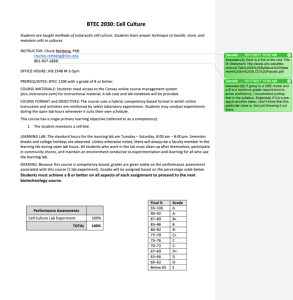BTEC 2030: Cell Culture

Program Description:
The Biotechnology program at Salt Lake Community College (SLCC) prepares students for transferring to higher education and employment in the biotech industry. SLCC offers a Biotechnology Associate of Science degree and a Certificate of Proficiency. Classes are offered in a competency-based education format. Curriculum outlines for the program and materials for additional courses are available to view separately.
Course Description:
This 1-credit Biotechnology Cell Culture course has students grow animal cell cultures. During the course, students learn how to thaw and transfer cryopreserved mammalian cells to media, observe growing cells using a phase contrast microscope, feed cells, count cells using a hemocytometer, subculture cells, transfect cells for fluorescence, screen cells for contamination, cryropreserve cells, and more.
Course Contents:
Course materials include a course curriculum outline, syllabus, and a Canvas .imscc file. The 3-page syllabus includes a brief description about the course, primary learning objectives, information about grading, course policies, and campus resources. The 3-page course curriculum outline includes a rationale for action, course learning outcomes, and course outcomes mapped to SLCC college-wide learning outcomes.
The .imscc file includes numerous folders and files from the Canvas course. Below is a list of modules, and a sample of topics, labs, and quizzes included in the course:
- Orientation Module
- Announcements
- Welcome
- How Competency-based Education Works
- Get to Know Your Course
- Using the Open Lab
- Learning and Technical Support
- Netiquette
- Introduce Yourself
- Any Questions? (optional)
- Cell Culture
- Cell Culture
- Growing Eukaryotic Cells
- Growth Media
- Equipment for Thawing Your Cells
- Lab #1 - Thawing Cryopreserved Cells
- Introduction to the Phase Contrast Microscope
- Using a Phase Contrast Microscope
- Happy, Healthy Cells
- Feeding Your Cells
- Lab #2 - Feeding Cells
- Are Your Cells Ready to Subculture?
- The Hemocytometer
- Counting Your Cells
- Protocol, Material, and Equipment for a Subculturing Cells
- Lab #3 - Subculturing Cells
- Introduction to Transfecting Mammalian Cells
- Lab #4: Transfecting Mammalian Cells
- TurboFect
- Observing Fluorescence in Eukaryotic Cells
- Protocol, Material, and Equipment for a Eukaryotic Cells
- Lab #5 - Eukaryotic Cell Transfection
- Contamination Screening by Observation
- Contamination Screening Through PCR
- Lab #6 - Contamination Screening
- Protocol, Materials, and Equipment for Cryopreservation
- Lab #7 - Cryopreservation
About this Resource

Comments